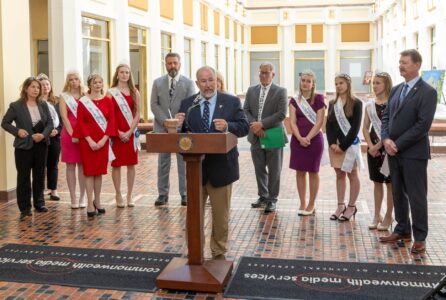Lasting Legacy program providing a ‘sense of meaning’ at Hospice

Times Observer photo by Stacey Gross The “Lasting Legacy” Initiative produces legacy books for Hospice patients.
“There is no greater agony than bearing an untold story inside you.”
Maya Angelou’s words illustrate what the women behind the Lasting Legacy Committee at Hospice of Warren County might consider a mission statement. Many patients, said Pat Carlson, “like to know they’re leaving something concrete.”
A partnership of Dr. Keith Price, Jean Walker, and Carlson, among others, the Lasting Legacy program has created around 20 books since 2014. The books are the result of volunteers who record interviews with Hospice of Warren County patients, which are then transcribed and printed through Blurb, an online self-publishing platform.
When a patient is enrolled in Hospice of Warren County, a team of caregivers is assembled to create a care plan that maximizes that patient’s quality of life through his or her end-of-life journey. Both interest and level of ability to create a legacy book are evaluated, and patients with the strength and ability to participate in an interview are offered the service.
The Lasting Legacy process, according to program literature, “has been found to significantly improve the participants’ sense of meaning, purpose, and dignity.”
And while interviewers do go into each interview with a list of questions to ask, Carlson said the list is more of a warm up option to get conversations started. “What they’re most proud of in life, advice they want to leave to their loved ones, or unique stories they want to share,” are all things interviewers might ask about. But what interviewers do best is listen for the kernels of stories and draw them out of patients.
Interviews last about an hour, said Carlson, and are recorded using a digital voice recorder. It’s important to record the interviews, said Walker, because when transcribing each interview part of the goal is to capture each patient’s unique storytelling voice.
We all understand the concept of “voice” when it comes to storytelling whether we realize it or not. And whether a writer is trying to craft a voice with which to tell a fictional story or our favorite relative is telling the same story she tells every year at Christmas dinner, we recognize that the way a person tells a story – the inflection, word choice, and vocal mannerisms that distinguish each of us from one another – is intensely personal, an identifying feature.
Capturing the storyteller’s voice during transcription, then, is essential. Carlson, who does most of the transcribing, says that capturing individuals on the page relies on a verbatim recording. Even pauses, coughs, chuckles, and interjections or asides are integral to accurately convey the person telling the story, as it’s the person as much as the story that’s being memorialized on the page.
Storytelling is basic to humanity. Before written language was even developed people gathered to share stories, true and fictional, and the stories themselves acted as bonding agents, creating community and relationships between individuals. It’s natural that storytelling would be an end-of-life activity. Telling the stories that feel important at the end of one’s life, stories that exemplify and illuminate the things they’ve learned, can be cathartic for the hospice patient, but it goes beyond that, said Walker and Carlson. It’s healing for families as well, who can hold the words, the stories, in their hands, reread them, and use the legacy books that remain after a loved one’s death to continue to nurture a connection with that person.
Sometimes, Carlson said, families or patients don’t feel that the legacy books are something they want to do but, once they’re done, tend to be glad they followed through with. “The stories we’ve heard through the making of these books,” both Walker and Carlson agreed, have been touching even for staff and volunteers. Vignettes of a life selected and related by patients nearing the ends of their lives, Carlson said, can be funny or tragic, beautiful or somber. The tone and content of the stories though, she said, is less important than the process of their being committed to the physical space of the page. And although Carlson and Walker, who does most of the editing once the transcription is finished, may have never even met the patient, by the time their work is done tend to feel like they’ve come to know and care for them as much as anyone who’s worked with them face to face.
Most patients, Walker said, “feel so proud” after finishing a book, and even though many patients don’t get to see the actual finished product they are able to see proofs of their stories and that’s enough.
Once the stories are transcribed, patients are able to choose pictures they want to add to the books, colors for covers and pages, and quotes or other minutiae they’d like to have added. The books are printed through Blurb and kept on file, so that copies can be printed and ordered on demand. Sometimes, Carlson said, families will order multiple copies. “Prices vary depending on the length of the book,” said Carlson. But the first copy, she said, is provided to the patient or family by Hospice of Warren County.
While Walker and Carlson said they initially played around with different ideas like scrapbooks and photo books, they wanted the finished product to be more about stories told in patients’ own voices and Blurb was the best medium to do that. The current process takes around 20 hours to create a book from start to finish, said Carlson, and while it’s time intensive it’s beyond rewarding.
“It’s a wonderful experience,” said Carlson. Both getting to know the people and the history lessons that she hears as she transcribes patients’ words have touched her. Also, she said, getting to know the other volunteers who work on the Lasting Legacy Committee has been a side benefit of the project for everyone involved.
“It’s really taken off,” said Walker.




